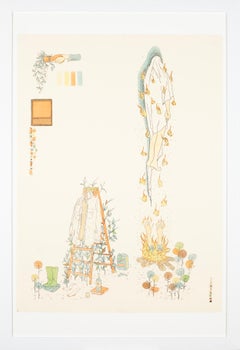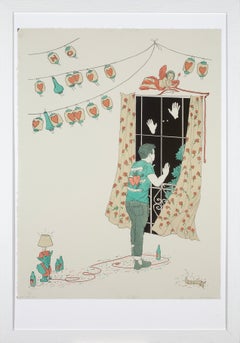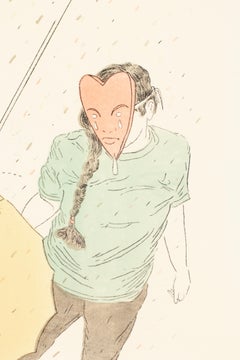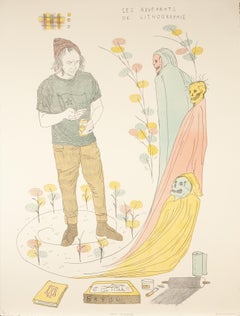Want more images or videos?
Request additional images or videos from the seller
1 of 8
Robert RedbirdUnknownUnknown
Unknown
$360List Price
About the Item
- Creator:Robert Redbird
- Creation Year:Unknown
- Dimensions:Height: 26.5 in (67.31 cm)Width: 21.25 in (53.98 cm)
- More Editions & Sizes:unknownPrice: $360
- Medium:
- Movement & Style:
- Period:
- Condition:
- Gallery Location:Columbia, MO
- Reference Number:1stDibs: LU1976213504152
About the Seller
No Reviews Yet
Vetted Professional Seller
Every seller passes strict standards for authenticity and reliability
1stDibs seller since 2022
48 sales on 1stDibs
Typical response time: 7 hours
Authenticity Guarantee
In the unlikely event there’s an issue with an item’s authenticity, contact us within 1 year for a full refund. DetailsMoney-Back Guarantee
If your item is not as described, is damaged in transit, or does not arrive, contact us within 7 days for a full refund. Details24-Hour Cancellation
You have a 24-hour grace period in which to reconsider your purchase, with no questions asked.Vetted Professional Sellers
Our world-class sellers must adhere to strict standards for service and quality, maintaining the integrity of our listings.Price-Match Guarantee
If you find that a seller listed the same item for a lower price elsewhere, we’ll match it.Trusted Global Delivery
Our best-in-class carrier network provides specialized shipping options worldwide, including custom delivery.You May Also Like
Modernist FOLK ART Original Pencil Lithograph "GRAY DAY AT THE BEACH"
By Doris Lee
Located in New York, NY
Doris Lee
Lithograph
1964
Edition Size: 250
Image Size: 12 x 9.5 inches
Sheet Size: 16.75 x 13 inches
Reference: AAA 1532
Signed lower left
Condition: Good
Provenance: ASA
Doris Emrick Lee...
Category
1960s Folk Art Landscape Prints
Materials
Lithograph, Archival Pigment
$1,100
H 17 in W 13 in D 1 in
Original El Empastre Autentica Comica Banda vintage poster
Located in Spokane, WA
Original Autentica Banda Comica “El Empastre” vintage poster. Archival linen backed in A- condition, ready to frame. Printed by Mirabet in Valencia, Spain.
El Empastre, a come...
Category
1940s Folk Art Portrait Prints
Materials
Lithograph
$749 Sale Price
20% Off
H 37.5 in W 25.5 in D 0.05 in
Descanso (Break)
By Jorge Dumas
Located in Fairlawn, OH
Signed, titled and numbered in pencil
Edition: 250 (5/250)
Signed, titled and numbered in pencil
Published by Circle Gallery Ltd.
Printer: Atelier Dumas, New York
Condition: Very good
Atelier Dumas opened in New York printing own work as well as
those of Peter Max, Agam, Romare Bearden, Dali, Erté, Peter Hurd,
Ting, Karl Appel...
Category
1970s Folk Art Figurative Prints
Materials
Lithograph
Leaving Home (97-301), 5 color lithograph on Rives BFK paper, Signed/N Tamarind
By DeLoss McGraw
Located in New York, NY
DeLoss McGraw
Leaving Home (97-301), 1997
Five color lithograph on tan Rives BFK paper with deckled edges
Signed and numbered 3/75 in graphite pencil on the front
17 × 24 3/25 inches...
Category
1990s Outsider Art Abstract Prints
Materials
Lithograph
Lithograph from from the Artsounds Collection, signed/n famed cult artist LGBTQ
By Thomas Lanigan-Schmidt
Located in New York, NY
Thomas Lanigan-Schmidt
Untitled, from from the Artsounds Collection, 1986
Lithograph on paper
Signed and numbered from the edition of 200 in ink on the back; also bears artist's stamped name and provenance - Art Sounds portfolio.
12 × 12 inches
Unframed
Signed and numbered from the edition of 200 in ink on the back; also bears artist's stamped name and provenance - Art Sounds portfolio.
This terrific offset lithograph print exemplifies the combination of religion and kitsch that Lanigan Schmidt is best known for. This print was created in the 1980s for the famous Artsounds portfolio, which featured prints by Marcel Duchamp, Jonathan Borofsky among others. Lanigan-Schmidt was a subject of a 2013 retrospective at PS1 MOMA and is on the faculty of the School of Visual Arts in New York.
Provenance:
Artsounds Portfolio
About Thomas Lanigan-Schmidt:
Thomas Lanigan-Schmidt is represented in the collections of the Metropolitan Museum of Art, Whitney Museum of American Art, MoMA, Brooklyn Museum, Ludwig Forum für Internationale Kunst, Ackland Art Museum, Columbus Museum of Art, and Wadsworth Atheneum Museum of Art, among others. He has exhibited extensively throughout the United States and Europe, including the 1980 and 1984 Venice Biennales, the 1991 Whitney Biennial, and the 1999 exhibition The American Century: Art and Culture, 1950-2000, Whitney Museum of American Art, New York, NY. Recent solo exhibitions include Tenemental: With Sighs Too Deep for Words, Howl! Happening, New York (2018); Thomas Lanigan-Schmidt: Mysterium Tremendum, Rockland Art Center, NY (2013); and Ecce Homo: Thomas Lanigan-Schmidt & The Art of Rebellion, Pavel Zoubok...
Category
1980s Outsider Art Figurative Prints
Materials
Lithograph
Autumn in New York by Jane Wooster Scott
By Jane Wooster Scott
Located in New York, NY
Jane Wooster Scott (American, b. 1920)
Autumn in New York, c. 20th Century
Lithograph
Sight: 15 x 12 in.
Framed: 27 3/4 x 23 3/4 x 1 in.
Signed and titled lower right in plate: Autum...
Category
20th Century Folk Art Landscape Prints
Materials
Lithograph
$700
H 27.75 in W 23.75 in D 1 in
Dances of Guanajuato, Folk Art Lithograph by Vic Herman
Located in Long Island City, NY
Vic Herman, American (1919 - 1999) - Dances of Guanajuato, Year: 1979, Medium: Lithograph, signed and numbered in pencil, Edition: 300, AP, Image Size: 13 x 23.5 inches, Size: 1...
Category
1970s Folk Art Figurative Prints
Materials
Lithograph
Filippe, Folk Art Lithograph by Vic Herman
Located in Long Island City, NY
Vic Herman, American (1919 - 1999) - Filippe, Year: circa 1979, Medium: Lithograph, signed and numbered in pencil, Edition: 300, AP 45, Image Size: 24 x 16 inches, Size: 29 in. ...
Category
1970s Folk Art Figurative Prints
Materials
Lithograph
High Hopes, Folk Art Lithograph by Vic Herman
Located in Long Island City, NY
Vic Herman, American (1919 - 1999) - High Hopes, Year: circa 1979, Medium: Lithograph, signed and numbered in pencil, Edition: 200, AP 30, Image Size: 26 x 15 inches, Size: 29 i...
Category
1970s Folk Art Figurative Prints
Materials
Lithograph
Tortillas are the Staff of Life, Folk Art Lithograph by Vic Herman
Located in Long Island City, NY
Vic Herman, American (1919 - 1999) - Tortillas are the Staff of Life, Year: 1979, Medium: Lithograph, signed and numbered in pencil, Edition: 200, AP 45, Image Size: 8.5 x 22 inc...
Category
1970s Folk Art Figurative Prints
Materials
Lithograph
More From This Seller
View AllDeal with the Dirt
Located in Columbia, MO
Kansas City, Missouri-born artist Emmett Merrill holds a BFA from the Kansas City Art Institute and an MFA from the University of Tennessee - Knoxville, and he is returning to the Ma...
Category
21st Century and Contemporary Contemporary Figurative Prints
Materials
Lithograph
Love Comes Back
Located in Columbia, MO
Kansas City, Missouri-born artist Emmett Merrill holds a BFA from the Kansas City Art Institute and an MFA from the University of Tennessee - Knoxville, and he is returning to the Ma...
Category
21st Century and Contemporary Contemporary Figurative Prints
Materials
Lithograph
No
Located in Columbia, MO
Kansas City, Missouri-born artist Emmett Merrill holds a BFA from the Kansas City Art Institute and an MFA from the University of Tennessee - Knoxville, and he is returning to the Ma...
Category
21st Century and Contemporary Contemporary Figurative Prints
Materials
Lithograph
Ghosts of Lithography
Located in Columbia, MO
Ghosts of Lithography
2022
Lithograph on BFK
24 x 18.25
Category
21st Century and Contemporary Contemporary Figurative Prints
Materials
Lithograph
Full Length Mirror
Located in Columbia, MO
Full Length Mirror
Lithograph 16/20
14 x 10 inches
Framed: 22 x 18 inches
Category
21st Century and Contemporary Contemporary Figurative Prints
Materials
Lithograph
Undressing for the Bath
Located in Columbia, MO
Undressing for the Bath
Color lithograph
Ed. A.P.
12.5 x 9.5 inches
Framed: 22 x 18 inches
Category
21st Century and Contemporary Contemporary Figurative Prints
Materials
Lithograph
Still Thinking About These?
All Recently ViewedMore Ways To Browse
John Kuhn
Jonah And The Whale
Keith Haring Apocalypse
Keith Haring Montreux
Keith Haring Signed Poster
Keith Haring South Africa
Le Cocu Magnifique
Leroy Neiman Golf
Leroy Neiman Originals
Les Caprices De Goya
Marc Chagall Green
Marc Chagall Rooster
Marc Chagall Unsigned Lithographs
Maria Rivans
Marker Keith Haring
Mermaid Poster
Moulin Rouge Cheret Original Poster
Ogata Gekko



